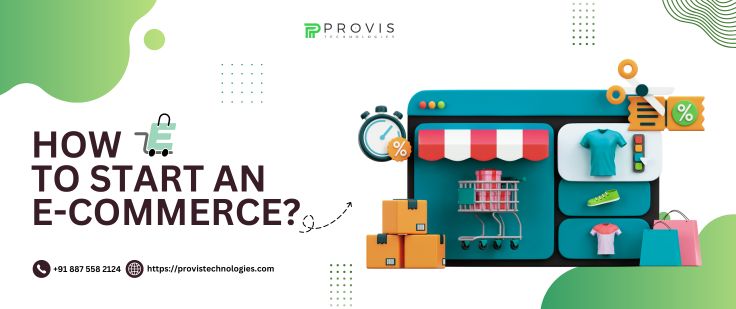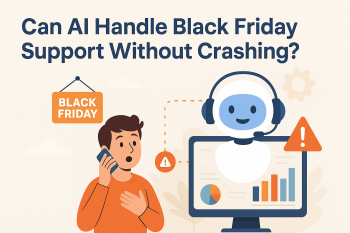E-commerce means purchasing & selling products & services over the Internet. Today, e-commerce has become increasingly popular due to its convenience & accessibility. This article will help you understand the fundamentals of starting an e-commerce and why starting it can be fruitful for your business. We will also look into the latest market trends and opportunities to help you make well-aware decisions about your upcoming venture.
How to Start an E-commerce?
Market Research & Validation
Before diving headfirst into your e-commerce business, it’s essential to do thorough market research to validate your idea. This involves identifying niche markets, analyzing competitors, and assessing market demand and viability. Also, it’s crucial to understand your target audience and competition to position your business for success and avoid potential pitfalls.
- Identify specific market segments with unmet needs or underserved audiences. This could involve analyzing trends, consumer behavior, and emerging industries to pinpoint lucrative opportunities.
- Know your competitors to analyze their strengths & weaknesses. This can help you identify gaps in the market and differentiate your business from existing players.
- Evaluate the demand for your products or services by conducting surveys, analyzing keyword search volume, and studying consumer preferences. Assess the viability of your business idea by considering factors such as market size, growth potential, and barriers to entry.
Defining Your Business Model
One of the critical decisions you will need to make when starting an e-commerce business is defining your business model. This includes choosing the products or services you will sell, deciding on the business structure (B2B, B2C, C2C), and developing a pricing strategy that aligns with your goals and target market.
- Select products or services that align with your target market and offer a competitive advantage. Consider product quality, uniqueness, and profit margins for informed decision-making.
- Determine whether your business will operate as a business-to-business (B2B), business-to-consumer (B2C), or consumer-to-consumer (C2C) model. Each model has its advantages & considerations, so choose the one that best suits your goals and target market.
- Make a strategy to balance competitiveness and profitability. Consider factors such as production costs, competitor pricing, and perceived value when setting prices for your products or services.
Creating a Business Plan
A well-thought-out business plan serves as a roadmap for your e-commerce venture, outlining your goals, strategies, and financial projections. It typically includes an executive summary, company description, market analysis, marketing & sales strategies, operations plan, and financial projections. A solid business plan will help you stay focused and organized as you launch and grow your business.
- Summarize the primary components of your business plan, including your mission statement, business objectives, and financial projections.
- Make an overview of your e-commerce business, including its history, mission, and vision. Describe your target market, competitive advantage, and unique selling proposition.
- Conduct a thorough analysis of your target market, industry trends, and competitive space. Identify opportunities & challenges that may impact your business’s success.
- Outline your strategies for attracting and retaining customers, including your marketing channels, promotional tactics, and sales forecasts.
- Detail how your e-commerce business will operate regularly, including your supply chain management, inventory control, and customer service processes.
- Forecast your e-commerce business’s financial performance over the next three to five years. Include projected revenues, expenses, profits, and cash flow statements to demonstrate the viability of your business model.
Don’t Miss:- The Future of E-commerce: Embracing SaaS Solutions
Legal Considerations
Navigating the legal aspects of starting an e-commerce business is crucial to ensure compliance and protect your interests. This includes registering your business, understanding taxation and licensing requirements, and adhering to e-commerce laws and regulations in your jurisdiction. Failing to address these legal considerations upfront could result in costly consequences.
- Choose a legal structure for your e-commerce business, such as sole proprietorship, partnership, LLC, or corporation. Register your business name and obtain any necessary licenses or permits for operation.
- Understand your tax obligations as an e-commerce business owner, including sales tax, income tax, and international tax regulations. Consult with a tax professional to ensure compliance and minimize tax liabilities.
- Familiarize yourself with e-commerce laws & regulations that govern online businesses, such as consumer protection laws, data privacy regulations, and electronic commerce regulations. Implement policies and procedures to safeguard customer data and comply with legal requirements.
Building Your E-commerce Website
Your e-commerce website is your virtual shop – it’s essential to invest time & resources into building a user-friendly site. This involves choosing the right e-commerce platform, such as Wix & WooCommerce, or an experienced e-commerce development agency like Provis Technologies for designing a website that reflects your brand identity. Integrate payment gateways and security measures to protect customer information.
- Choose a well-reputed e-commerce platform that meets your business requirements. Consider factors such as ease of use, customization options, scalability, and integrations with payment gateways and third-party tools.
- Create a visually appealing and intuitive website design that enhances the user experience. Optimize your site for mobile devices, ensure fast loading times, and include navigation & calls-to-action to guide visitors their way through.
- Choose secure payment gateways to process online transactions safely and efficiently. Implement SSL encryption, PCI compliance, and other security measures to protect customer data and build trust with your audience.
Must Know:- Dive into Multi-vendor Marketplaces: Your Path to E-commerce Dominance
Product Sourcing & Inventory Management
Sourcing quality products & managing inventory is crucial for a successful e-commerce business. Whether sourcing from suppliers or manufacturing your products, maintaining adequate inventory levels and implementing efficient fulfillment and shipping solutions are essential for meeting customer demand and ensuring timely delivery.
- Identify reliable suppliers or manufacturers for your products and negotiate favorable terms & pricing. Establish strong relationships with suppliers to ensure consistent quality and timely delivery of inventory.
- Regularly monitoring your inventory levels will prevent stock-related issues. Implement inventory management software to track stock levels, forecast demand, and automate reorder processes for optimal inventory control.
- Choose fulfillment & shipping solutions that meet your business needs and budget. Options include in-house fulfillment, third-party logistics (3PL) providers, drop shipping, and fulfillment by Amazon (FBA)- select the option that offers the best balance of cost, speed, and reliability for your e-commerce business.
Marketing & Sales Strategies
Effective marketing and sales strategies are essential for driving traffic to your e-commerce website and converting visitors into customers. This includes leveraging search engine optimization (SEO), content marketing, social media marketing, email marketing, and influencer partnerships to reach your target audience and generate sales.
- Website optimization helps to improve search engine visibility, which in turn helps bring organic traffic. Conduct keyword research, optimize on-page elements, and build high-quality backlinks to enhance your search engine rankings and drive targeted traffic to your site.
- Create valuable, informative content that resonates with your target audience and establishes your authority in your niche. Publish blog posts, videos, infographics, and other content formats to engage your audience and drive traffic to your e-commerce website.
- Harness the power of social media to connect with your audience, build brand awareness, and drive traffic to your e-commerce website. Choose the right social media platforms for your target market, create engaging content, and interact with your followers to foster meaningful relationships and drive conversions.
- Build an email list of subscribers and nurture them with targeted email campaigns. Segment your email list based on demographics, interests, and purchase history to deliver personalized content and offers that resonate with your audience and drive sales.
- Collaborate with influencers and brand ambassadors to reach new audiences and increase brand visibility. Identify influencers who align with your brand values and target audience, and partner with them to create authentic content and promote your products to their followers.
Customer Service & Support
Providing exceptional customer service is crucial for building customer trust & loyalty. Implementing live chat and help desk solutions, handling returns & refunds promptly, and offering customer loyalty programs are just a few ways to ensure a positive shopping experience and keep customers coming back for more.
- Offer live chat support & helpdesk solutions to assist customers in real-time and address their concerns promptly. Provide multiple channels for customer support, including email, phone, and social media, to accommodate different preferences and ensure a positive shopping experience.
- Establish clear policies & procedures for handling returns & refunds to streamline the process and minimize customer dissatisfaction. Communicate your return policy clearly on your website and provide hassle-free returns to build trust & confidence.
- Reward loyal customers with exclusive perks, discounts, and rewards to incentivize repeat purchases and increase customer retention. Implement a customer loyalty program for customers to encourage them to continue shopping on your platform.
Scaling Your Business
As your e-commerce business grows, it’s essential to scale strategically to accommodate increased demand and maintain profitability. This involves analyzing metrics and key performance indicators (KPIs), expanding product lines or market reach, and investing in technology and automation to streamline operations and drive continued growth.
- Monitor metrics & KPIs to track your online store’s performance and identify areas for improvement. Analyze data related to sales, traffic, conversion rates, customer acquisition costs, and customer lifetime value to make informed decisions and optimize your business strategies.
- Diversify your product offerings or expand into new markets to capitalize on growth opportunities and reach new customers. Conduct market research to identify emerging trends and introduce new products to fuel expansion.
- Embrace technology to streamline your e-commerce operations and improve efficiency. Invest in e-commerce tools and software that automate repetitive tasks like order processing, inventory management, and customer support – to free up time and resources for strategic initiatives & business growth.
Related Blog:- E-commerce Evolution: Trends & Technologies Shaping the Industry
Bottom Line
Like any business, an e-commerce business too needs planning & passion to be successful. By following the steps outlined in this guide and staying informed about industry trends and best practices – you can position your business for long-term success in the dynamic and ever-evolving world of online commerce.
FAQs
How much money do I need to start an e-commerce business?
Investment varies based on your business model & goals. It’s better to plan your budget wisely and prioritize expenses according to your priorities.
Do I need coding skills to build my e-commerce website?
No! You don’t need coding skills to build your e-commerce website. Many platforms offer user-friendly website builders that require little to no technical knowledge. You can also hire a top e-commerce development agency like Provis Technologies for your e-store.
How can I find reliable suppliers for my e-commerce business?
Finding reliable suppliers involves research. Attend trade shows, utilize online directories, and prioritize quality, reliability, and communication when selecting partners. Provis Technologies is one of the best e-commerce developers.
What are effective marketing strategies for e-commerce?
Effective marketing strategies for e-commerce include SEO, content marketing, social media marketing, email marketing, and influencer partnerships. Tailor your approach based on your target audience and business objectives.
How can I ensure the security of my e-commerce website and customer data?
Ensure the security of your e-commerce website and customer data by implementing SSL encryption, choosing secure payment gateways, and regularly updating your website’s software and plugins.
How do I measure the success of my e-commerce business?
Measure success through metrics like sales revenue, conversion rates, customer acquisition costs, and customer retention rates. Regularly track these metrics and adjust your strategies to optimize your e-commerce business’s performance.
Written By
Author's Picks
- Boost Your Brand with Custom E-commerce Solutions
- 26/04/2024
- Top Features every successful E-Commerce Website needs in 2024
- 24/11/2024
- 10 E-commerce Website Security Measures Every Online Store Needs in 2025
- 03/04/2025
Categories
- AI for Startups
- AI in Web Development
- AI Integration
- AI Platforms
- AI Prompt
- AI Tools
- AI Trading Software
- Android App
- Android vs iOS Development
- Angular
- API
- API Development
- App
- app development
- App Idea
- App User Feedback
- Application
- Artificial Intelligence
- Audit Services
- Automotive Industry
- Awards and Recognition
- Business Consulting
- Business Website
- Chatbots
- CRM
- CRM for Financial Advisors
- Custom CRM
- Custom SaaS
- Custom Website
- Customer Service
- dashboard design
- Developing a Mobile App
- Digital Business
- E-commerce
- EMR Integration
- Finance
- Financial Advisors
- Financial Advisors
- GIT
- Health Insurance
- iOS App
- iOS App Development
- IoT Mobile App Development
- IoT Platforms
- IT Audit Services
- IT Consulting
- IT Strategies
- Java Development
- Laravel
- Lean Canvas
- Learning Management System
- Logistics Apps
- Mobile App Development
- MVP
- Native App
- News Aggregator Site
- OTT
- Outsourcing IT
- Payment Gateway
- predictive analysis
- Product Launch Strategy
- Progressive Web App (PWA)
- Prototype
- Recommender Systems
- Ruby
- SaaS
- SaaS Application
- SaaS Business
- SaaS Company
- SaaS Development
- SaaS Product
- SaaS Project
- Sales Funnel
- SEO
- Shopping Cart
- Software Development
- SSL and TLS
- Startup Checklist
- Technology
- Tetradic Color Scheme
- UI/UX Design Company
- Unit Testing
- User Flow
- User Testing
- Web Development
- Web Performance Optimization
- website Maintenance Services
- Website Migration Service
- Website Speed Optimization
- WooCommerce
- WordPress





